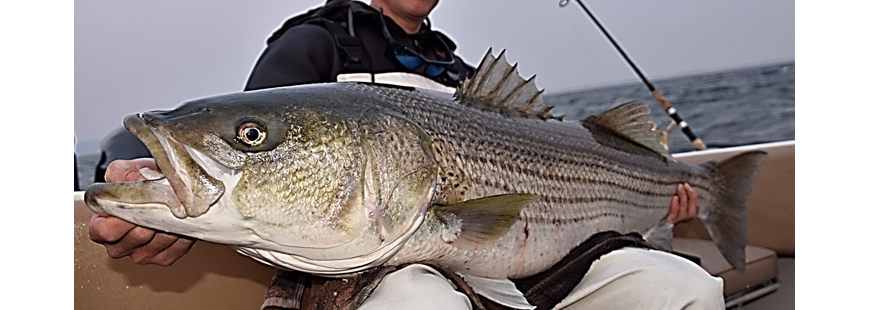On December 16, 2024, conservation-minded striped bass anglers waited to see whether the Atlantic States Marine Fisheries Commission’s (ASMFC) Striped Bass Management Board (Management Board) would vote to reduce 2025 striped bass landings, and so make it more likely that the currently overfished striped bass stock would be rebuilt by 2029, the deadline set by the ASMFC’s striped bass management plan.
Those anglers were also eager to see whether the Management Board would take any action to protect the 2018 year class of striped bass, which will be the focus of recreational harvest in 2025. Such harvest may prove problematic, as striped bass have experienced poor spawning success in every year since 2019; removing a substantial portion of the 2018 year class from the population could have a profound negative impact on the future health of the striped bass stock and the future sustainability of the striped bass fishery.
Concerned anglers were ultimately disappointed, as the Management Board decided against imposing any new harvest reductions and chose to leave the 2018 year class vulnerable to recreational fishermen in 2025. Instead, it voted to initiate a new addendum to the management plan, which might include new management measures for the 2026 season.
The Management Board’s failure to take any immediate action at its December meeting could be attributed to confusing and inadequate information received by the fisheries managers, insufficient time to develop clear management options, and a recreational fishing industry that is becoming increasingly opposed to striped bass conservation efforts. But in many anglers’ eyes, the inaction was due to the Management Board relapsing into its former habits of deferral and delay, as it used the ambiguity in the available data as an excuse to sit on its hands and do nothing.
Ambiguity pervaded the 2024 stock assessment update (2024 Update). Because Addendum II to Amendment 7 to the Interstate Fishery Management Plan for Atlantic Striped Bass (Addendum II) had been adopted less than a year earlier, the ASMFC’s Striped Bass Technical Committee (Technical Committee), which prepared the 2024 Update, didn’t yet have enough data to determine whether the measures contained in that addendum would make it likely that the stock would rebuild by 2029.
The Technical Committee did know that recreational landings for the first half of 2024 were substantially lower than expected. If that trend continued through the rest of the year, there was a 50-50 chance that the stock would rebuild even if no management changes were made. But in 2025, the strong 2018 year class would enter the 28- to 31-inch coastal recreational slot size limit. That could cause recreational landings to increase significantly, making it unlikely that the stock would rebuild on time.
Addendum II gave the Management Board the authority to adopt measures to make rebuilding more likely by a simple Board vote, without having to go through the formal public comment process that is normally required before it adopts a new addendum. Thus, at the Management Board’s October meeting, Nichola Meserve, a Massachusetts fisheries manager, declared that “The only error I see is doing nothing…some type of action is necessary,” and moved to hold an additional meeting in December 2024, to discuss new measures for 2025. The motion passed with strong support, but also met with strong opposition from a few Management Board members who preferred to delay any management action until 2026.
Prior to the December meeting, the Technical Committee produced a report that presented three possible scenarios, all equally likely and all based on slightly different assumptions. Depending on which scenario one chose to believe, the stock either had a 57 percent chance of rebuilding on time, even if no additional management measures were adopted, or had only a 43 or 46 percent chance of rebuilding by 2029 unless landings cuts were imposed.
There was no clear path forward. The way was further obscured by the report’s proposed season closures, which considered neither the length nor the timing of recreational striped bass fisheries in different states, and so would place a materially greater burden on some states than on others. The report also presented options for both traditional no-harvest closures, which still allowed catch-and-release fishing, and closures which prohibited directed catch-and-release fishing as well, even though various law enforcement officials noted that such “no-targeting” closures were, as a practical matter, unenforceable.
Despite having only five days after the release of the Technical Committee’s report to respond, the public provided 4,360 comments to guide the Management Board. 3,370 of those comments called for the Management Board to adopt new management measures for the 2025 season, while just 517 supported the status quo, making it clear that stakeholders preferred immediate action over delay or inaction by at least a 6.5 to 1 ratio.
2,726 of the commenters believed that any reduction that was imposed should apply to both the commercial and recreational sectors, while only five asked that it apply solely to anglers. Emile Franke, the Fishery Management Plan Coordinator for striped bass, noted in a memo to the Management Board that “Most comments supported both sectors taking even reductions (same percent reduction for each sector). A small number of comments supported each sector taking a reduction based on its contribution to total removals (e.g., commercial 1.5% and recreational 16%).”
Ms. Franke’s memo also noted strong opposition to no-targeting closures in the ocean fishery, with 2,252 comments opposing closures of any kind (perhaps an unreasonable position, given the few alternatives available to the Management Board) and 640 specifically opposing no-targeting closures. Of the 746 comments supporting no-targeting closures, 700 only wanted such closures applied to anglers fishing within the Chesapeake Bay.
As the December 16 webinar meeting began, more than 550 people were listening in.
The Technical Committee presented its report to the Management Board and answered a number of questions. Immediately thereafter, Adam Nowalsky, New Jersey’s Legislative Proxy, made a motion
to initiate an addendum to support striped bass rebuilding by 2029 in consideration of 2024 recreational and commercial mortality while balancing socioeconomic impacts. Options should include, if needed, a range of overall reductions, consideration of rec vs comm contributions to the reductions, rec season and size changes taking into account regional variability of availability, and no harvest vs no target closures. Final action shall be taken by the Summer 2025 meeting to be in place for the 2026 rec and comm fisheries.
The motion was seconded by John Clark, a Delaware fisheries manager who had long opposed any reductions in striped bass landings.
Both Nowalsky and Clark cited uncertainty in the Technical Committee’s report as justification for delaying action, arguing that such delay gave scientists more time to gauge the impact of Amendment II. They also observed that, if the most optimistic of the Technical Committee’s three possible scenarios proved accurate, the striped bass stock would probably rebuild on time without the need for additional action.
Nichola Meserve responded with an elaborate substitute motion which proposed a nine percent reduction in recreational and commercial striped bass landings, and also addressed the perceived inequities in the seasons proposed by the Technical Committee, split the coast into two regions divided by the Connecticut/Rhode Island border, and set other state- or region-specific requirements. Her motion was seconded by Cheri Patterson, a fishery manager from New Hampshire.
Megan Ware, the Maine fishery manager who chairs the Management Board, then initiated a general discussion, and invited amendments to both the main and the substitute motions.
Ray Kane, Massachusetts’ Governor’s appointee, reminded the Management Board that “We’ve heard from the public already that they want action from this Board,” and noted that delay would earn the Management Board little new information. Despite his comment, it soon became evident that many of Management Board members were deaf to the public comments.
An initial motion to limit the commercial quota reduction to a meaningless one percent barely failed on a seven-to-seven vote. A second motion, to limit such reduction to five percent, made by Emerson Hasbrouck, the Governor’s appointee from New York, passed with 10 votes in favor and just four opposed.
Soon after, New Jersey’s Nowalsky ignored both law enforcement advice and 3,000 public comments, moving to amend the substitute motion so as to allow the use of no-targeting closures in coastal fisheries and in Virginia’s portion of the Chesapeake Bay. Nowalsky, long an adamant opponent of more restrictive management measures, effectively admitted that his motion was meant to be a thumb in the eye of conservation advocates, noting that “People who support conservation at any cost are backing off” once no-targeting closures are put on the table.
Hasbrouck seconded the motion, saying that it “addresses an issue that has been concerning me, and that issue is equity versus inequity;” he felt that it is unfair to allow catch-and-release fishing when harvest-oriented anglers can’t put dead fish on the dock. Somewhat surprisingly, given the unenforceability of no-targeting closures and the strong public opposition, the motion passed with nine votes in favor and five opposed.
At that point, debate on the amended substitute motion began.
Doug Grout, New Hampshire’s Governor’s appointee, citing both the need to meet the rebuilding deadline and the threat posed by recent years of low recruitment, warned “If we don’t approve an action today we will do nothing to address the increase in harvest that will occur in 2025.” Chris Batsavage, a North Carolina fishery manager, expressed concern about the future, observing that “we could be looking at some pretty lean times after 2029.”
Other members of the Management Board had no such worries. Joseph Cimino, New Jersey’s fisheries manager, said that because of Nowalsky’s amendment, his views on the substitute motion were “going from strongly opposed to opposed,” and felt that “the stock can handle” the consequences of any delay. Maryland’s Luisi argued that the various management measures adopted since the early 2000s “added complexity” to the management plan, and said that the substitute motion constituted “complex analyses piecemealed together,” while an addendum provided the opportunity to be “creative” with new management approaches.
But perhaps the most remarkable opposition to the substitute motion came from Michael Waine, a spokesman for the American Sportfishing Association (ASA), the recreational fishing industry’s largest trade organization. Following up on the ASA’s comments opposing landings reductions in 2025, Waine said:
…I think the public process is really important for such a significant decision of season closures…And so, I think giving the addendum the opportunity to consider this more thoroughly, really develop options out that the public can consume and provide input on is the best way best path [sic] forward. You know, I think about [sic] you guys know I am a part of a lot of these fisheries management discussions, and this is probably the most unique fishery that ASMFC manages, especially recreationally. And I look at the public comments, and I know there’s millions of striped bass anglers out there. Millions. And I’m only seeing twenty five hundred comments from a lot of the same people that we know have been commenting. And so, as an organization, we’re going to work with our members to try to get more people integrated into this process. We know that the recreational fishery is very diverse, and I don’t feel the public comments really are a good reflection of that diversity. And so, where is the opportunity to get those individuals into this process? Where is the opportunity to give folks the chance to get involved and engaged? I don’t think it’s on the fly with this substitute motion, and I challenge the Board to go the addendum route and reach out to the constituents that they haven’t heard from. Don’t talk to the same folks that you’ve been talking to all the time. Find the people who care about this resource and value it in a way that their voices should be heard, too. And that’s what we’ll do as an organization ourselves. [emphasis added]
There was unintended irony, as Waine seemingly told the Management Board to ignore what he was saying (“I am a part of a lot of these fisheries management discussions…Don’t talk to the same folks that you’ve been talking to all the time”). But his request that the Management Board ignore stakeholders who had taken the time to learn about the issues and make their views known, because some imagined, Nixonian silent majority might disagree, was sincere and a cause for concern.
Dennis Abbott, New Hampshire’s legislative proxy, who noted that the Management Board had received 4,000 public comments, asserted that “contrary to Mike Waine, you’ll never get one million comments.” He warned that the public has already blamed the ASMFC for “kicking the can down the road” with respect to striped bass management, and that they’d blame the ASMFC once again if no action was taken.
In the end, whether because the various amendments to the substitute motion had turned what had been an elegant solution to a multifaceted problem into a quagmire likely to cause intense and possibly fruitless debate between the states in each region, or whether the proponents of the proposed new addendum simply convinced a majority of the Management Board that their approach was best, the substitute motion failed on a vote of four in favor and eleven opposed, while the original motion to begin the addendum process found broad support, with only Maine and New Hampshire voting against it.
Waine’s supposed silent majority notwithstanding, many striped bass anglers were disappointed by the outcome. Nelson Sigelman, an angler and outdoor writer from Martha’s Vineyard, observed, “The history of fisheries management is a tale of half-measures taken to appease various interest groups who all want a slice of a diminishing pie. Tough action is put off every year, and the pie gets smaller.”
His words were kind compared to some on the popular striped bass fishing website Stripersonline.com, where anglers made such comments as:
“and the word today is Malfeasance, wrongdoing or misconduct especially by a public official.”
“The states did not have the courage to vote for conservation today. They did nothing.”
“Pathetic. Congrats to all involved.”
“Somehow, someway the asmfc needs to go. I don’t know how that happens but there is not a path forward with them running things.”
Responding to such public sentiment, Megan Ware said:
We want to thank the thousands of members of the public who took the time to provide thoughtful comments ahead of the Board meeting. We understand that many will be disappointed in the Board’s decision to initiate an addendum versus taking immediate action. However, after deliberating for more than three hours about the path forward, the Board came to the conclusion that that the best course of action is to proceed with an addendum which will allow for clarity on 2024 removals and additional analyses.
While her attempt at damage control will probably do little to assuage the public, a more important question is what the decision to delay management action means for the striped bass.
At this point, it’s impossible to say.
If the Technical Committee’s most optimistic scenario proves true, the striped bass will still have a slightly better than even chance to rebuild by 2029. That scenario depends on fishing mortality remaining low for the rest of 2024, rising by 17 percent in 2025, and then dropping back to 2024 levels for 2026 through 2029.
2024 landings will probably be at least as low as the Technical Committee has predicted. But such low landings were unexpected, and if it turns out that 2024 landings were atypical, and if landings levels increase to more typical levels in future years, the fishing mortality assumptions underlying the proposed new addendum will be overly optimistic. In that case, any management measures included in the proposed addendum will probably not be restrictive enough to rebuild the stock on time.
If that happens, the Management Board will only learn of the problem after the 2027 benchmark stock assessment is released. The Management Board will have little time to implement measures capable of rebuilding the stock by the 2029 deadline, and any such measures will probably be far more restrictive than the nine percent reduction recently rejected by the Management Board.
They might even be restrictive enough that the Management Board decides to ignore the rebuilding deadline, despite the explicit language of the management plan.
Thus, December 16’s decision to delay management action might well determine whether the Management Board will meet its rebuilding deadline. If spawning success remains poor, that decision might also determine the health of the striped bass stock, and the sustainability of the striped bass fishery, in the 2030s, if not beyond.
We can only hope that the cost of delay doesn’t prove disturbingly high.


